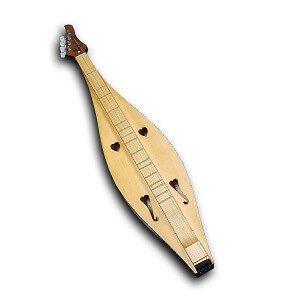Appalachian Dulcimer
 The Appalachian dulcimer is a strummed box-zither chordophone of the United States. During the 19th century the dulcimer was found widely distributed throughout rural Appalachia, where, along with the violin, it was used to accompany ballads and dancing amongst immigrant settlers. Up until the 1950s its use was restricted to the music making in these remote rural communities, although a few folk music enthusiasts carried out studies and encouraged players to preserve their tradition. In the 1950s, during the folk revival movement, American folk singers introduced the Appalachian dulcimer to a wider and more urban audience, triggering an interest in the making of dulcimers by hobbyists across the country.
The Appalachian dulcimer is a strummed box-zither chordophone of the United States. During the 19th century the dulcimer was found widely distributed throughout rural Appalachia, where, along with the violin, it was used to accompany ballads and dancing amongst immigrant settlers. Up until the 1950s its use was restricted to the music making in these remote rural communities, although a few folk music enthusiasts carried out studies and encouraged players to preserve their tradition. In the 1950s, during the folk revival movement, American folk singers introduced the Appalachian dulcimer to a wider and more urban audience, triggering an interest in the making of dulcimers by hobbyists across the country.
The elongated oval-shaped resonator is constructed from four pieces of thinly shaven soft wood glued together. The soundboard and back are flat, the two sides gently bent over their length. All these pieces come together at and are glued to internal blocks at the top and bottom ends of the resonator. A diamond-shaped soundhole is cut into the soundboard. Over much of the length of the soundboard there is a narrow raised fretboard (21 inches long, 1.1 inches wide) with shallow grooves cut across it to accept fourteen brass wire frets. A high bridge is glued to the soundboard an inch from its bottom end, and an equally high nut is glued near its opposite end at the end of the fretboard. A thin but solid pegblock is joined to the top resonator block and is outfitted with a four-unit metal machine head on its backside with lateral tuning buttons. Each of the four metal strings has a noose at one end which is looped around one of two wooden tail pins imbedded in the side of the bottom resonator block. The strings then pass through slots in the bridge and continue over in a parallel plane the fretboard until they pass through slots in the nut. They then are threaded through and wound around the capstan of their machine head, which is used to adjust the string tension.